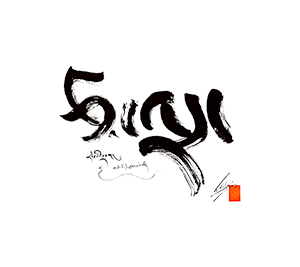The
Śrīmālādevīsiṃhanādanirdeśa (ŚSN; The Lion's Roar Teaching of Queen Śrīmālā) is one of the most famous
Mahāyāna sūtras representative of the
Tathāgatagarbha theory. In this
sūtra, Queen Śrīmāla, who is the daughter of King Prasenajit of Śrāvasti and is married to King Yaśomitra of Ayodhyā, relates her understanding of the true doctrine (saddharma) to which the Lord Buddha listens and gives his affirmation. This
sūtra employs the narrative of Queen Śrīmālā to express the
Tathāgatagarbha theory that "although all beings are enmired in
afflictions (
kleśa), in essence they are the same as the Buddha, that is, all living beings dwell within the womb (garbha) of the Tathāgata (i.e., Buddha)." Since this
sūtra, like the
Vimalakīrtinirdeśasūtra, is being expounded by a layperson instead of the Buddha, it is representative of the non-monastic form of religion typical of
Mahāyāna Buddhism, and historically enjoyed immense popularity in China and Japan.
There are two Chinese translations of the
sūtra: the Guṇabhadra (求那跋陀羅) version translated
in A. D. 436 called the
Shengman shizihou yicheng dafangbian fangguang jing 勝鬘師子吼一乘大方便方廣經, T. 353, vol. 12 <ŚSN (Ch.1)>); and the Bodhiruci (菩提流支) version of A. D. 710 called the
Shengman furen hui (
勝鬘夫人會, T. 310(48), vol. 11 <ŚSN(Ch.2)> ), which is the 48th
sūtra of the
Ratnakūṭa collection (
Da bao ji jing 大寶積經) There is also a ninth century Tibetan translation called the '
Phags pa Iha mo dpal 'phren gi seṅ ge'i sgra śes bya ba theg pa chen po'i mdo <ŚSN(Tib.)>. The English translation by Alex and Hideko Wayman is based on the Chinese translation.
[1] Readers are referred to this work for more detailed information. There is also a great deal of research that has been done on this
sūtra by Japanese scholars, which we will not touch upon here.
The original version of this
sūtra has been lost, and there are only a few fragmentary quotations in Sanskrit in the
Ratnagotravibhāga and the
Śikṣāsamuccaya. In The Schøyen Collection, however, I was able to discover three virtually complete folios that cover the final portion of the
sūtra as well as another two fragments related to other sections. As the
sūtra ends on the recto side of folio no. 392,
[2] the verso side of the same folio begins another
sūtra which is the subject of the next report in this volume. In the following, I will introduce the above mentioned three folios and two fragments related to the ŚSN. (Matsuda, "Śrīmālādevīsiṃhanādanirdeśa," 65)
